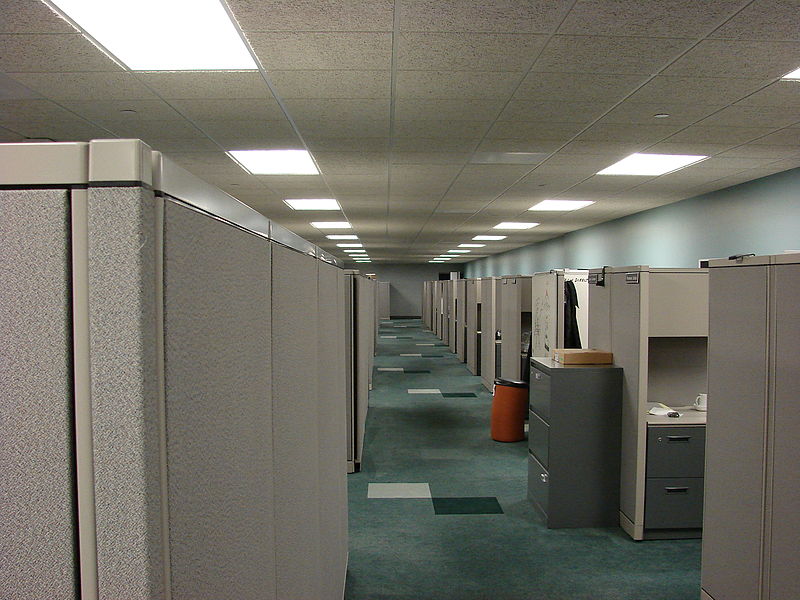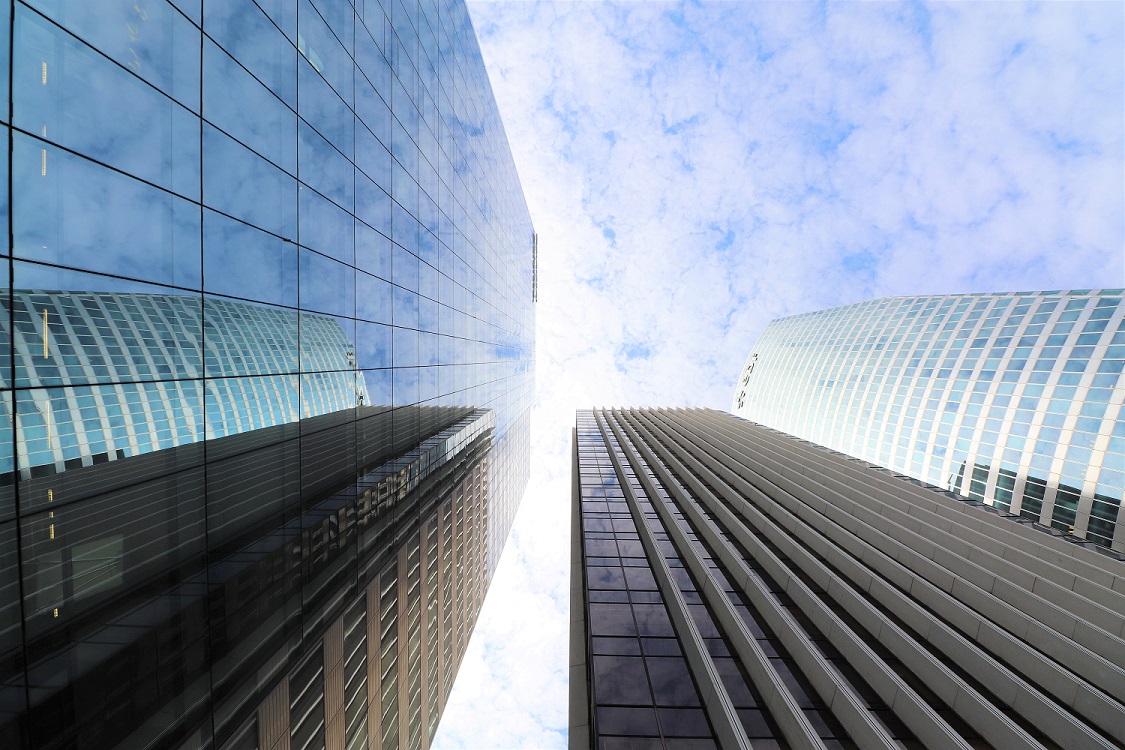Post-pandemic cities are bouncing back to a new normal, but office buildings remain stubbornly below capacity. How can they be repurposed for a new economy?
With a majority of Americans now believing that the pandemic is behind us (despite an excess death rate that says otherwise), daily life is steadily approaching a new normal. People are returning to restaurants and movie theaters, unafraid of inhaling the public’s anonymously launched respiratory droplets. This is good news for many businesses and shareholders, but one sector that isn’t roaring back with nearly so much enthusiasm is office real estate. In city centers across the U.S., office buildings remain at partial capacity, losing both economic and social value.
Emergency measures that allowed us to work from home during the pandemic proved that remote work isn’t only possible for more people than we were led to believe, it also taught us just how satisfying it is to skip the commute, take a walk at lunch, toss a load of laundry in before that Zoom meeting, and have more face time with the people we love. As a result, the push for remote (or at least hybrid) work is an enduring feature of the new normal, at least for people with higher wages or educational attainment.
Despite management’s deep desire to babysit employees, making sure they’ve got fingers on keyboards and not taking a minute too long in the bathroom, the opportunity to work remotely has become a critically important benefit for many job seekers. So much so, that companies offering flexible work schedules are hiring at roughly twice the rate as those that don’t. In the second quarter of 2023, 51% of companies offered some variety of remote work, up from 43% in Q1.
Companies without flexible work options have had a harder time attracting talent. Perhaps it’s all that “extra collaboration” going on in offices that results in people having to take more work home at the end of the day just to get it all done. (Spoiler: That’s not the kind of “work from home” that people are into anymore.)
Remote work may be what employees crave, but won’t someone think of the office buildings?
The number of remote workers phoning it in to employers in cities with vast business districts, like San Francisco and New York, is so high that it’s driving down the value of commercial real estate. Occupancy rates are about half of what they were before the pandemic, and while that would seem like savings for companies that can condense their space and sell off a significant fraction of their holdings (or simply move out at the end of their leases), it doesn’t work like that in a market where everyone is doing the same thing.
That causes downstream problems for those whose livelihoods depend upon demand for office buildings. Of course there are the coffeeshops, corner stores, and sandwich slingers falling into precarity, but we can also expect more bank foreclosures, lost tax revenue, and desperate landlords (try not to feel too sad about those). San Francisco employers have so many remote workers that the city lost $484 million in tax revenue in 2021. Between home-based work situations and tech company layoffs in recent years, San Francisco area office buildings are cluttering the market, but since they’re not yet dropping to fire sale prices, buyers aren’t exactly lining up.
With about $24.8 billion worth of distressed office real estate across the United States and banks nervous about their loan portfolios, one would think that the perfect solution would be to turn what we don’t need – big city offices – into what we do need, such as affordable housing. Developers are taking stabs at this, because it’s an obvious opportunity to make a buck, but it comes with a load of problems.
For starters, it’s not as simple as one might think to convert office buildings into residential apartments.

Before WWII, office buildings were narrower, shorter, with more window frontage. Without air conditioning or so much artificial light, surrounding workers with windows to let in fresh air and sunlight was the norm. These older buildings are much easier to convert to residential units than newer buildings with larger floor plates. In the post-war era, technological advances enabled more efficient office buildings with more space inside, but who wants to live in the center space of a large floor, in an apartment without windows? Some architects get around this by cutting a square “light well” straight down through the middle of a building, allowing some sunlight to penetrate a tall, narrow void around which apartments can be created, but is that really a desirable, million dollar view?
“Million dollar” may not be an exaggeration, here. Such conversions are not easy, and harder equates to more expensive. Commercial buildings have centralized utilities and structural features which make it difficult to distribute plumbing or appropriate HVAC to subdivided units. Floors and beams could need reinforcements. Zoning may also prohibit mixed-use districts or require a certain number of windows per unit. Changing all of this takes money, all to create a product (residential housing) that rents for a lower price per square foot than the original use (office space). Such expensive repurposing requires economic incentives, such as tax breaks from governments which are, themselves, hemorrhaging revenue from gutted business districts. Absent subsidies, the new apartments have to be marketed to an upscale clientele accustomed to paying for luxury, which means it probably won’t become affordable housing.
Consider this office converted to (barely) livable residential space. Would you pay big bucks to live here? If you’re like most, probably not.
So, what else can be done with vacant office buildings?
There has been some movement toward repurposing them as vertical farms. Fancy lettuces don’t care if their environs are soulless former cubicle farms, but they also don’t visit local restaurants unless they’re on the plate. Vertical farms have their own problems, such as blocking out the sun and rain and then having to engineer replacements with electricity and metered water, while still making a profit. Plus, they’re more suited for twee gourmet delights like out-of-season strawberries and herbs, rather than the kind of calorie-rich staple foods that feed the masses. Still, it is a purpose of sorts.
Forbes is more optimistic, hoping that would-be innovators will leap into the void with their own re-imagined uses for unwanted office buildings, but the best suggestion they offer is turning them into homeless shelters, with centralized kitchens and, presumably, no need to create individual spaces for individual people.
Other suggestions include storage units, classrooms, food distribution centers, rentable workspaces for individuals or smaller businesses, microgyms one can rent by the hour, private event venues, art or photography studios, and pop-up retail (think of those seasonal, short-term Halloween stores). Whether people would commute to use such places regularly, or if there would be enough demand to soak up the country’s vacant office inventory, remains to be seen. It would also be easier to repurpose such spaces if the new uses didn’t also need to generate revenue to justify their existence.
As societies change and economies inevitably shift, figuring out how to repurpose or dispose of obsolete infrastructure is an ongoing reality. The challenge may seem daunting, but it’s nowhere near as formidable as what we’ll have to do when cities, themselves, become uninhabitable. Perhaps, as our medieval ancestors did, our descendants will comb through our abandoned sites for useful materials, a kind of futuristic spolia with which to build their settlements. By then, vacant office buildings will not rank on our list of problems anymore.
Related: Considering Life After the Pandemic


Join the conversation!